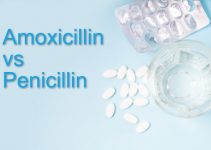
What is the difference between two semi-synthetic antibiotics – Amoxicillin and Ampicillin?
Ampicillin
Ampicillin is a broad-spectrum antibiotic belonging to a group of semi-synthetic penicillins. Its purpose is to destroy the cell membranes of bacteria, which leads to their death. The drug has bactericidal properties.
The puddle acids of the gastric juice cannot destroy Ampicillin. Besides, it affects some gram-negative microorganisms, such as Salmonella, Shigella, Escherichia coli. Doctors prescribe this drug to treat mixed types of infections.
The use of Ampicillin is indicated for the following diseases:
- Pneumonia.
- Lung abscesses.
- Acute respiratory infections.
- Peritonitis.
- Cholecystitis.
- Sepsis.
- Intestinal infection.
- Postoperative soft tissue infections.
- Escherichia coli.
- Urinary tract infections.
- Gonorrhea
Ampicillin Dosage
Your doctor will determine the dosage individually, depending on the disease’s severity.
Usually, the adult dosage for oral use (tablets) is 250-500 mg 2-4 times a day.
A single dose for children should not exceed 50 mg.
Contraindications And Side Effects
The most common contraindications include:
- Hypersensitivity to penicillin.
- Liver failure.
- Bronchial asthma.
- Hay fever.
Side effects most often include various allergic reactions (itching, urticaria, red skin, edema). In rare cases, people experience anaphylactic shock.
Amoxicillin
Amoxicillin is a semi-synthetic antibiotic with bactericidal properties. It has a wide spectrum of action, affecting Gram-positive and Gram-negative bacteria.
The drug has an excellent effect on various groups of coccus infections, including Escherichia coli, Salmonella, Klebsiella, and Shigella.
Amoxicillin is resistant to acids, making it effective even when administered orally. Physicians prescribe it to fight penicillin-degrading microorganisms resistant to the active ingredient.
The main indication for the use of Amoxicillin are the following bacterial infections:
- Pneumonia.
- Severe forms of bronchitis.
- Pyelonephritis.
- Angina.
- Renal pelvis inflammation.
- Urinary tract infections (cystitis, urethritis).
- Inflammation of the intestines.
- Gonorrhea.
The drug is also used to treat diseases caused by microorganisms sensitive to Amoxicillin.
Before the doctor prescribes this antibiotic, it is better to determine how sensitive bacteria are to the active substance. Then a doctor can calculate the required dosage based on this test.
Amoxicillin Dosage
The dosage is set individually according to the type of infectious disease and the complexity of treatment.
Usually, adult people take 300mg of Amoxicillin 3 times a day. More complex forms of infections involve increasing the single dose to 1000mg.
Children aged 5 to 10 years should take 250mg 3 times a day. Children under five years should use 200mg of the drug a day divided into three doses.
Contraindications and Side Effects
Individual intolerance to the drug’s active components is the main contraindication to using Amoxicillin.
Manufacturers note a special caution for using Amoxicillin in people suffering from severe liver and kidney diseases. It is not recommended to use the drug if you have high fever, chills, and increased lymph nodes.
Pregnant women should use the antibiotic only under the supervision of a doctor.
Adverse reactions can include allergies, red skin, rashes, itching, edema.
The drug can cause rhinitis, conjunctivitis, provoke joint pain, in rare cases, cause anaphylactic shock.
What Do Ampicillin and Amoxicillin Have In Common?
These two drugs are the undisputed sales leaders in their field. They have proven to be effective against various types of infections and microorganisms.
These semi-synthetic drugs belong to the same antibiotics group with a broad spectrum action. Both remedies have identical indications for use, are simple, inexpensive, and readily available.
What Are The Differences Between Ampicillin and Amoxicillin?
The difference between Ampicillin and Amoxicillin is in the history of the creation of these drugs. The thing is that Ampicillin was discovered much earlier. Thus, most microorganisms have managed to adapt and develop immunity to this antibiotic. That is why doctors are using Ampicillin less and less.
Another distinguishing feature is Amoxicillin’s broader range of effects on harmful bacteria. Based on the hydroxyl group of substances, the drug penetrates the blood much faster, which creates a higher concentration of the active substance in the blood, providing a cumulative effect.
